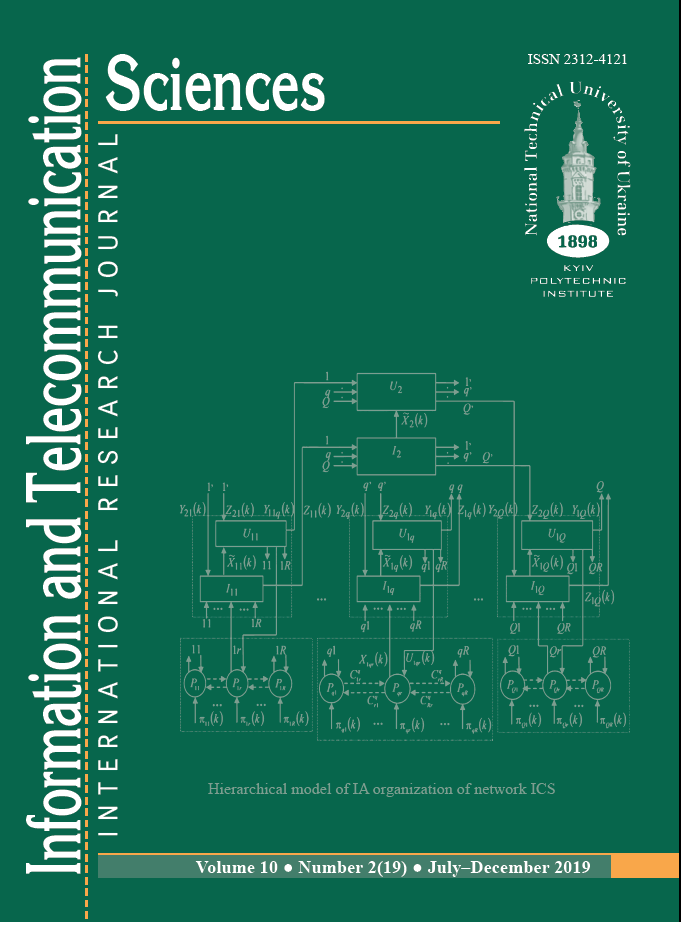INTELLIGENT CONTROL SYSTEM FOR WSN AND MANET
DOI:
https://doi.org/10.20535/2411-2976.22019.12-21Keywords:
WSN, MANET, UAV, control, agent.Abstract
Background. New hierarchical model of intelligent control system (ICS) for wireless sensor (WSN) and mobile adhoc networks (MANET) is proposed. There was formulated a mathematical statement of the problem of finding a rational WSN topology using unmaned aerial vehicals (UAVs), which consists of a problem of sensor localization in monitoring zone and a problem of UAV relay localization in the space for the organization of connected network with desired characteristics.
Objective. The aim of the paper is to develop the hierarchical model for intelligent agents interaction for the MANET or sensor class radio network control system development.
Methods. We use mathematical methods and algorithms (graph theory, vector optimization methods, fuzzy algorithms, dynamic programming algorithm) and computer simulation to describe hierarchical model of intelligent control system for WSN and MANET.
Results. The novelty of the model lies in using the graph theory to make a formal description of the functional subsystems of the network ICS (vertices of the graph) and their interaction processes (edges of the graph). Using the proposed model can accelerate and systemize the network design process considering their functioning environment and
hierarchical structure of their ICS.
Conclusions. Using the intellectual agents technology and multiagent systems allows minimizing the service traffic and use network and node resources more efficiently.
References
Conti M. Mobile ad hoc networking: milestones, challenges, and new research directions / Conti M., Giordano S. // Communications Magazine, IEEE. – Vol. 52, Issue 1. – Р. 85 – 96.
Concept of hierarchical design of intelligent control systems of MANET class tactical radio networks / [Sova O., Romanyuk V., Zhuk P., Romanyuk A.] // 22nd international conf. “UHF and telecommunication technologies” Crimico-2012. – Sevastopol: Crimico – 2012. – pp. 265 – 266.
Romayuk V. Target functions of operational control of tactical radionetworks / Romanyuk V. // Collection of scientific work of MITI NTUU “KPI”. – 2012. – № 1. – pp. 109 – 117.
Russel S. Artificial intelligence. A modern approach / Russel S., Norvig P. – Wiliams, 2007. – 1408 p.
Bugaichenko D. Design and implementation of methods considering formal and logical specifications of self-tuning multiagent systems with time constraints: PhD thesis : 05.13.11 / Bugaichenko Dmitrii Yurievich. – SPb., 2007. – 259 p.
Analysis of possibilities of intelligent agents usage for building the node control systems for MANET / [Sova O., Simonenko O., Romanyuk V., Umanec Y.] // Collection of scientific work of MITI NTUU “KPI”. – 2013. – № 1. – p. 76 – 84.
Gavrilova T. Knowledge bases of intelligent systems / Gavrilova T, Horoshevski V. – SPb.: Piter, 2000. – 384p.
Romanyuk V. Architecture of MANET control systems / Romayuk V., Sova O., Zhuk O. // Conf. “Problems of telecommunications - 2011”. – К.:ITS NTUU “KPI” 2011. – p. 77.
Minochkin A. Objective, multiagent model of operational control of mobile component of a new generation military network / Minochkin A., Shacilo P. // Collection of scientific work of MITI NTUU “KPI”. – 2008. – № 3. – pp. 107 – 118.
Minochkin A. Methods of decision making in a mobile radio network control system / Minochkin A., Romanyuk V. // Collection of scientific work of MITI NTUU “KPI”. – 2006. – № 1. – pp. 66 – 71.
Methods of processing the knowledge about a situation in MANET network for building intelligent node control systems / [Sova O., Romanyuk V., Minochkin D.,Romanyuk A.] // Collection of scientific work of MTI STU. – 2014. – № 1. – pp. 97 – 110.
Blumin S. Methods of decision making in an uncertain environment / Blumin S., Shuikova I. – Lipetsk: LEGI, 2001. – 138 p.
K. Lorincz, D. J. Malan, T. R. F. Fulford-Jones, A. Nawoj, A. Clavel, V. Shnayder, G. Mainland, M. Welsh and S. Moulton, “Sensor Networks for Emergency Response: Challenges and Opportunities,” Pervasive computing, 2004, Vol.10-11, pp. 16-23.
M. V. Ramesh, S. Kumar and P. V. Rangan, “Wireless Sensor Network for Landslide Detection,”International Conference on Wireless Networks (ICWN’09), Las Vegas, June 14, 2009, pp. 1–7.
Z. Sun, P. Wang, M. C. Vuran, M. A. Al- Rodhaan, A. M. Al-Dhelaan and I. F. Akyildiz, “BorderSense: Border patrol through advanced wireless sensor networks,” Ad Hoc Networks, 2011, Vol.9, pp. 468-477.
O. I. Lysenko, S. V. Valuiskyi, “Capacity increasing of sensor telecommunication networks,” Telecommunication Sciences, 2012, Vol.3, №1, p. 5–11.

